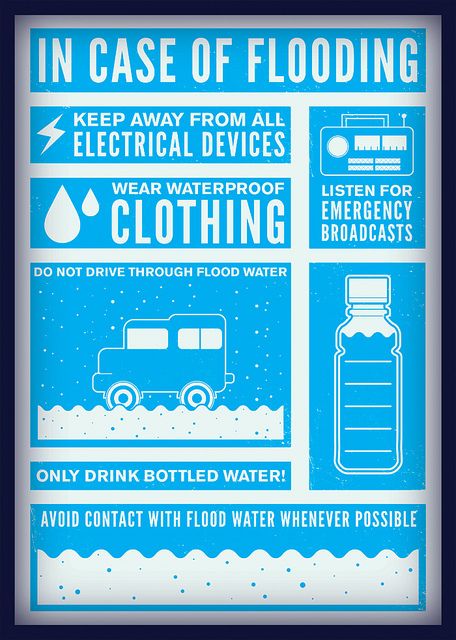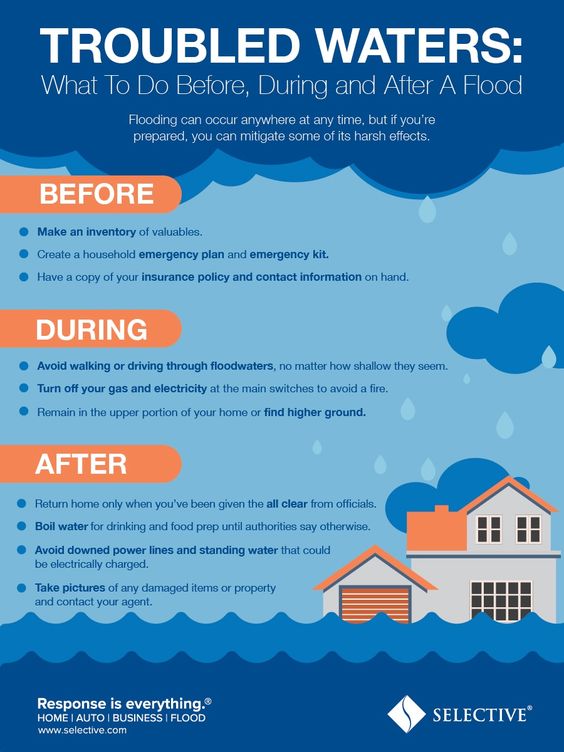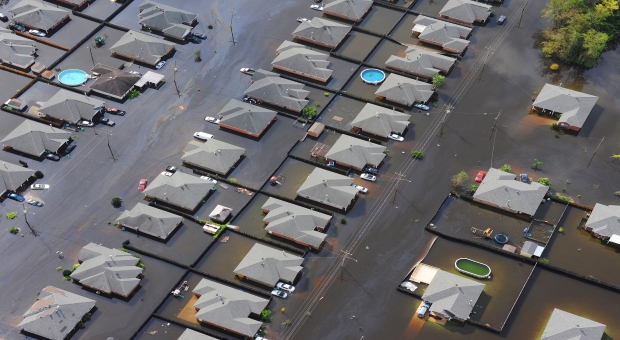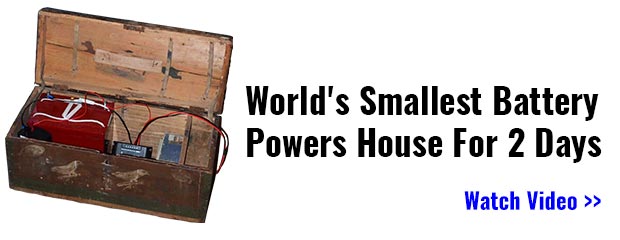When it comes to natural disasters, few things will cause as much trouble and destruction as flooding.
After experiencing a few scenarios involving floods, I can tell you it’s almost surreal how quickly flood waters rise and how powerless it makes you feel.
In the United States floods are causing much more distress and damage than any other natural disaster. I’ve experienced flash floods in the deserts of the Southwest, and I’ve also helped my brother in the Midwest with spring flooding. Over the years, I’ve learned that people need to know more about these natural disasters and what to do in case it hits home.
GREEN ENERGY – Click here to find out how you can build your own energy generator.
Floodwaters are a destructive and lethal force, and you need to be prepared to escape them, but also to handle their aftermath. You need to take time to prepare if you happen to live in an area prone to flooding.
Here are my top tips to prepare for floods
1. Build an emergency kit
Having a bug out bag is ideal in this case, but there are all sorts of personal emergency kits that can be built. It really doesn’t matter if you make a “one-for-all” kit or if each member of your family has their own kit. The kits(s) should contain essentials that you can grab and go without thinking too much about it.
A few of the essentials your emergency kit should contain: water, non-perishable food, cash, crank radio, batteries, a cell phone charger (preferably solar), first aid kit, sanitation items, favorite toys of your young ones, important documents and at least one change of clothes.
2. Have an escape plan
Every member of your family should know what to do in case flooding is announced. An emergency escape plan is similar to a bug out plan, but it’s much more simplified. Most escape plans concentrate on the designated meeting area and the follow-up once everyone gets together.
Both the meeting area and the location that will host you until the waters recede should be safe and clear for flooding. This needs to be seriously considered and planned for since floods can have a rapid and unpredictable development. It may seem a minor problem at first, but a sudden change in the weather can have a disastrous outcome.
 3. Know your area
3. Know your area
It bugs me when people show up on the TV after a flooding and say, “we didn’t know it can happen to us.” It’s quite simple to research the dangers of flooding in your area, and it just takes a little will. There are flood hazard maps available at fema.gov, and with a simple and quick research, you will be able to discover what the threat is in your area based on historical records.
4. You may need to rethink the layout of your utilities
After the first flood hit my brother’s house, he decided to install the water heater and furnace on an elevated platform. This helped him better protect them and save money in case it happens again.
There are all sorts of things you can do to protect your home and valuables. As a quick example, he also installed a sump pump with backup power. It takes time figuring out the weakness of your home, but once you manage to do that and put a little effort into reinforcing them, you will save a lot of money in the long-run.
Another advice I can give you is to anchor any fuel tanks and structure your yard hosts. Your shed will not be swept away during floods if you provide good anchoring.
5. How about tetanus shots?
As a general rule, I keep my tetanus shots up to date. Since I like to do a lot of exploring in unknown territory, this has become a required practice for myself. Now, when it comes to flooding, I recommend you follow the same rule. Even a small puncture wound can lead to serious infection during floods.
6. Don’t forget about the utilities
When you see the water rising, the number one thing you should do is to turn off all power and disconnect your appliances. A lot of people panic during those times and they forget to turn off gas and electricity.
Most accidents happen because people concentrate on what they could salvage with complete disregard towards their safety. Remember to do things the smart way and once you turn the utilities off you will be able to safely move your furniture and other important items to the higher levels in the house.
7. Install check valves
A simple item like a check valve will protect your water lines. I recommend installing some if you want to avoid floodwaters backing up into your water lines.
8. Bring everything of value inside
Besides protecting your lawn furniture by bringing it inside, you will also avoid turning it into a debris hazard. There are all sorts of things laying in your yard, and you need to gather and store them properly when flooding is announced. Follow this rule if you want to see all your stuff again after the water recedes.
9. Sandbagging entrances
During floods, a lot of people spend a lot of time and effort to sandbag doorways and basement windows. This is smart thinking but to a certain extent. If your house has poor insulation, the sandbags will only delay the inevitable.
In my honest opinion, rather than breaking your back with the sandbags, I would recommend concentrating on moving stuff to the higher levels. Once again, this is a different scenario from household to household, and only you should decide how to act since you’re the only one who knows how well your house was built.
Click HERE to Get the World’s Smallest Battery, That Powers Your House For More Than 2 Days!
10. Dealing with pets
Learning how to take care of your pets and protect them during a natural disaster should be mandatory if you have animals on your property. When Hurricane Maria hit Puerto Rico, a friend of mine sent me a video of his neighbor’s house, and it broke my heart seeing two horses tied to a concrete fence. The waters were rising very fast, and the rapid currents made it impossible for my friend to reach them. They drowned without having any chance to fight for their lives.
If you have pets, take them with you. If you have other animals that you can’t evacuate, you can set them loose. It’s the least humane thing you can do, to give them a fighting chance.
11. Take care of your underground tanks
Some may have an underground tank to store fuel while others may use them to store water. Regardless of what you are using them for, all your underground tanks should be secure and properly sealed.
12. Protect all the items you are unable to take with you
You won’t be able to carry everything you own in your truck, and you need to properly protect the items you leave behind. One thing I’ve learned is that heavy-duty plastic bags are ideal for packing and protecting items of value (from books to trophies and pretty much everything you can think off).
Another smart thing I’ve learned from my brother is to use the washing machine and dishwasher to store valuable items. If you want to waterproof your items, these appliances are ideal.
13. Make sure your vehicle is prepared
Besides having a full tank of gas, you need to be sure your vehicle can handle the road ahead. This means you need to be able to change a tire, free your car in case it gets stuck, drive during various weather conditions and overall, be able to do some light repairs.
One again, I will stress the need to have a full tank of gas since people seem to often forget about this. Fuel will be hard to find following a flood, and I advise you to keep a canister or two of fuel in the garage to be on the safe side.
 14. Don’t drive into flooded areas
14. Don’t drive into flooded areas
I’ve mentioned being able to drive during changing weather, but you should also be aware of the dangers of driving through flooded areas. While common sense will tell you to avoid these areas, some people will choose to ignore their “survival instinct” and drive right through. While some people believe their car is too heavy to float and they end up being washed away from the road, most folks fail to acknowledge the dangerous debris under the surface. Your car may be damaged to the point it will not run, and you will end up being stranded on top of your vehicle in rising waters.
15. Listen to emergency broadcasts
While same will wait until an area has been declared safe to enter, some folks don’t have the patience to wait for the emergency updates. They rush back home to protect their house from looters or to assess the damage, and start the cleaning process.
Be smart about it and wait. The weather can change suddenly, and you will end up stranded or worse.
16. Avoid walking through floodwaters
One of the worst experiences I had with floods was when my wife developed an allergic reaction after getting in contact with floodwater. Her legs started swelling, and it developed a rash that was spreading to her thighs. I had to rush her to the emergency where they gave her an antihistamine shot and various medication. They said the allergic reaction was probably caused by some chemicals in the water.
This shows you that you should avoid contact with floodwaters as much as possible. There could be all sorts of contaminants in the water (oil, chemicals, sewage, etc.).
17. Don’t forget about your cellar
If you have the time and if it’s possible you should move the stuff from your cellar to a high-elevated place. After the first flooding, my brother started moving the food items from the cellar into his attic every time there was a flood warning/announcement.
If you want to avoid your food items and any other stockpile being contaminated or destroyed, you can follow the same rule. You will move stuff only temporarily, so there’s little risk of food getting spoiled.
18. Give a helping hand or some good advice
One thing you can do when a flooding warning is issued is help your neighbors. This, of course, if you have took care of your own preparations. Besides helping older folks to secure and protect their stuff, you can also teach your surrounding neighbors on what to do when flooding hits. Based on your experience and the experience of others, you can learn a lot of things that can be applied to each case. I would never have tough of using my dishwater to protect stuff from flooding waters if it wasn’t for my brother.
You can gather a lot of information, just by organizing a friendly gathering and discuss what your neighborhood has gone through.
19. Don’t forget about the disaster tool kit
In a recent article, I wrote about why preppers should build a disaster toolkit, what it should contain, and how it can help them. Having a disaster toolkit is mandatory for the cleanup process, but it can also be quite useful during the development of a natural disaster.
During a flood situation, waters may rise faster than you would expect, and people will seek refugee higher and higher in their homes. In the majority of cases, most of them will seek refuge on a second floor while others will go for the roof or the attic. Unfortunately, the ones seeking refuge in the attic will often drown because they don’t have a way of escaping. They don’t have the tools to break out of the attic, and they get stuck up there waiting for help to arrive.
20. Understand how flooding works
In dry areas flash floods are common and develop very quickly. The hard, scorched soil in Arizona creates fast-moving waterways once it rains in the mountains and valleys. However, in colder parts of the country, folks often experience ice damn flooding created by precipitation mixing with the ice. The rainfall pushes the ice, and it creates a natural dam. Once the dam breaks, all the water being held back rushes downstream or into surrounding areas. On the other hand, those living near the ocean will often experience coastal flooding, which is often connected to dangerous storms.
As you can notice, flooding can have various forms, and it develops differently from one region to another. This is why people should understand how flooding occurs in their area and how to better protect themselves and what’s theirs.
Concluding
Flooding is a destructive and life-altering natural disaster that I feel is still not given the proper importance. From swept-away homes to those who are filled with debris and mold, few can escape the destructive nature of floods. If you are prepared, you can better protect your family and your home from this destructive flow.




















































































I live in the Houston area and during our last flood, Harvey 2017 we personally lucked out. We only had 2″ of water in the house. As I watched so many people walking in the flooded streets carrying a few possessions in plastic bags I had an idea. Rather than using a bug out bag or trash bag to carry your stuff a 5-gallon bucket with a screw on gamma lid would be best. The bucket would be water tight with the gamma lid and it would float. Even a younger child could pull it along in the flood waters if necessary. Sure, you should stay out of the water but if it gets 2′ or 3′ or higher in the house what’s your options. Just an idea.